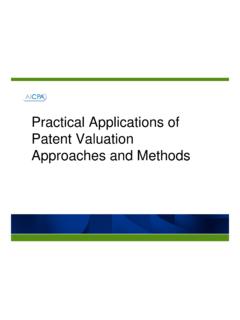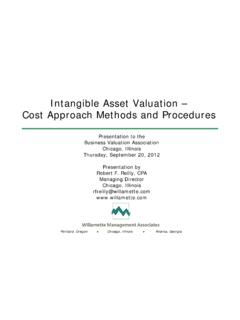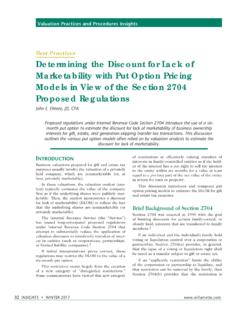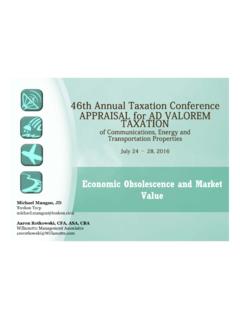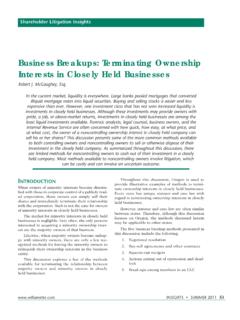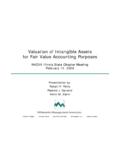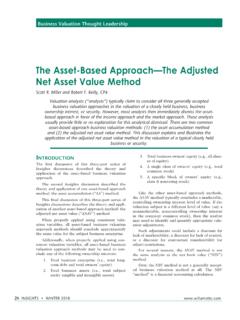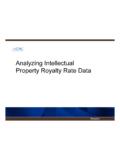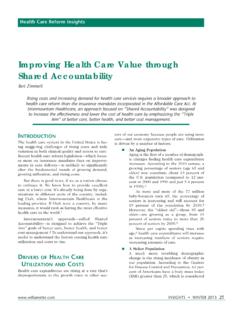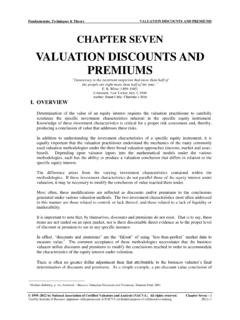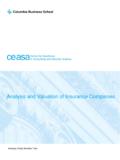Transcription of ESTIMATING COMPANY-SPECIFIC RISK PREMIUM IN COST …
1 19 Summer 2008 Insights ESTIMATING A COMPANY-SPECIFIC RISK PREMIUM IN THE COST OF CAPITAL FOR AD VALOREM TAX valuation PURPOSEST imothy J. MeinhartUnit valuation InsightsThe COMPANY-SPECIFIC risk PREMIUM should be considered in all unit valuation analyses performed for ad valorem tax purposes. This is because an investment in the subject taxpayer corporation operating assets is typically more risky than an investment in a diversified portfolio of marketable securities that is, the benchmark that is typically used to estimate the taxpayer corporation cost of equity capital.
2 While the estimation of a COMPANY-SPECIFIC risk PREMIUM is ultimately based on the valuation analyst s professional judgment, this discussion presents(1) various factors that may be considered by the valuation analyst and (2) several procedures that may be used by the valuation analyst to estimate the COMPANY-SPECIFIC risk premiumin an ad valorem tax unit states and some local jurisdictions centrally assess utility, transportation, communications, and similar com-panies for ad valorem tax purposes. These industrial and commercial taxpayer corporations are typically assessed based on the use of unit (or business enterprise) valuation methods, as opposed to the use of summation (or property build-up) valuation tax assessors (and taxpayer corporation valua-tion analysts) perform a unit valuation , they use the three generally accepted property valuation approaches that is, the cost approach, the sales comparison approach, and the income approach.
3 The most common income approach valuation methods are yield capitalization method and the direct capitalization estimate the value of the subject taxpayer corpo-ration unit of operating assets, the yield capitalization method uses a present value discount rate, and the direct capitalization method uses a direct capitalization rate. Both the discount rate and the direct capitalization rate reflect required rates of return on investment, given the risk asso-ciated with the subject taxpayer corporation relationship between risk and expected return is one of the fundamental cost of capital issues related to the unit valuation for ad valorem tax purposes.
4 valuation analysts use generally accepted procedures for measuring expected investment rates of return. These measures include net present value, internal rate of return, payback period, profit margin, return on assets, and return on invested capital. valuation analysts also use generally accepted pro-cedures for measuring the taxpayer corporation property investment risk. These procedures include measures of the general equity risk PREMIUM , the industry adjustment risk PREMIUM , and the size adjustment risk , valuation analysts do not have generally accepted procedures for measuring COMPANY-SPECIFIC risk.
5 This statement is correct in spite of the fact that the con-cept of a COMPANY-SPECIFIC risk adjustment in measuring the taxpayer corporation cost of capital is generally accept-ed. Mostly due to empirical data constraints, the analytical mechanics for quantifying the COMPANY-SPECIFIC risk premi-ums are not as rigorous as the analytical mechanics used to quantify the other cost of capital , the topics addressed in this discussion are twofold: (1) identifying COMPANY-SPECIFIC investment risk and (2) measuring the COMPANY-SPECIFIC risk PREMIUM (CSRP).
6 This discussion reviews several sets of factors that valuation analysts typically consider when selecting the appropriate CSRP in an ad valorem tax unit discussion also summarizes the procedures that valuation analysts typically use to select a specific CSRP measurement based on the valuation analyst s assessment of the relevant CSRP Summer 200820 COMPANY-SPECIFIC RISK PREMIUM TERMINOLOGYIn the current academic literature related to invest-ment analysis and portfolio management, company -spe-cific risk is interchangeably referred to as: investment- specific risk, property- specific risk, nonsystematic risk, unsystematic risk, nondiversifiable risk, and idiosyncratic risk.
7 With regard to the ad valorem unit valuation of taxpayer corporation operating assets, while the term investment- specific risk seems most appropri-ate, the term COMPANY-SPECIFIC risk appears to be most commonly latter terminology is appro-priate for purposes of this discus-sion. This is because most of the risk factors that are specific to the subject unit of operating assets also affect the taxpayer corporation that is the owner/operator of the subject taxable of the terminology used to name this type of risk, the CSRP is typically the last compo-nent applied when quantifying the taxpayer corporation s total investment risk.
8 It is the component of risk that makes an investment in the subject taxable property (1) unique and (2) different from any benchmark investments that are used to measure capitalization rates, valuation pricing multiples, and other valua-tion pricing many (but not all) types of property transactions, investors expect to be compensated for the assumption of COMPANY-SPECIFIC risk. However, investors generally do not expect to be compensated for the CSRP in those types of security sale transactions in which the COMPANY-SPECIFIC risk can be diversified risk diversification process is a conceptual corner-stone of modern corporate finance principles.
9 However, the following discussion explains why this risk diversification process is typically not applicable in the unit valuation of taxpayer corporation operating of what name is assigned to this particular type of taxpayer investment risk component, COMPANY-SPECIFIC risk is difficult to (1) identify, (2) measure, and (3) correlate with the appropriate incremental rate of TO CONSIDER COMPANY-SPECIFIC RISK IN THE UNIT valuation OF TAXPAYER CORPORATION OPERATING ASSETSC ompany- specific risk should be considered in every ad valorem tax unit valuation where the taxpayer corporation operating assets are:1.
10 Not perfectly liquid,2. not perfectly diversified, or3. not subject to limited investments that lack the risk mitigation influences of liquid-ity, diversification, and limited lia-bility, COMPANY-SPECIFIC risk cannot be diversified away. For investments that benefit from these particular risk mitigation influences, compa-ny- specific risk can be diversified away (in part or in total).The CSRP is used directly in the income approach when the valu-ation analyst estimates the cost of equity capital for pur-poses of:1.
